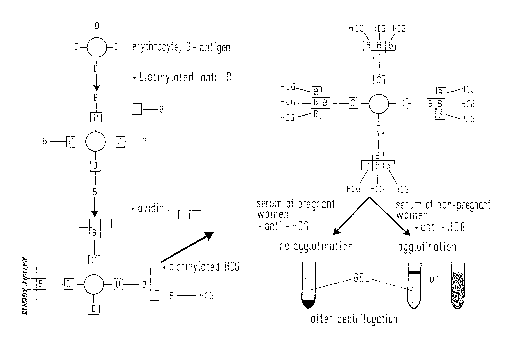Some of the information on this Web page has been provided by external sources. The Government of Canada is not responsible for the accuracy, reliability or currency of the information supplied by external sources. Users wishing to rely upon this information should consult directly with the source of the information. Content provided by external sources is not subject to official languages, privacy and accessibility requirements.
Any discrepancies in the text and image of the Claims and Abstract are due to differing posting times. Text of the Claims and Abstract are posted:
| (12) Patent: | (11) CA 2090392 |
|---|---|
| (54) English Title: | COUPLING OF ANTIGENS AND ANTIBODIES TO NON-FIXED ERYTHROCYTES |
| (54) French Title: | COUPLAGE D'ANTIGENES ET D'ANTICORPS A DES ERYTHROCYTES NON FIXES |
| Status: | Term Expired - Post Grant Beyond Limit |
| (51) International Patent Classification (IPC): |
|
|---|---|
| (72) Inventors : |
|
| (73) Owners : |
|
| (71) Applicants : |
|
| (74) Agent: | NORTON ROSE FULBRIGHT CANADA LLP/S.E.N.C.R.L., S.R.L. |
| (74) Associate agent: | |
| (45) Issued: | 2000-01-11 |
| (22) Filed Date: | 1993-02-25 |
| (41) Open to Public Inspection: | 1993-08-26 |
| Examination requested: | 1993-02-25 |
| Availability of licence: | N/A |
| Dedicated to the Public: | N/A |
| (25) Language of filing: | English |
| Patent Cooperation Treaty (PCT): | No |
|---|
| (30) Application Priority Data: | ||||||
|---|---|---|---|---|---|---|
|
1. In order to determine an analyte in an aqueous sample
solution by agglutination of non-fixed erythrocytes, one
proceeds according to the present invention in such a
way that
(a) erythrocytes are incubated with one or several
antibodies or/and antibody derivatives which do not
lead to premature agglutination whereby the
antibodies or/and antibody derivatives are directed
towards one or several antigens on tie erythrocyte
membrane and whereby before or after incubation
with the erythrocytes the antibodies or/and
antibody derivatives are coupled to a first binding
partner of a high affinity binding pair,
(b) a second binding partner of the high affinity
binding pair is incubated with the treated
erythrocytes from (a) whereby the second binding
partner is chosen such that it has more than one
binding site per molecule for the first binding
partner,
(c) the first binding partner of the high affinity
binding pair which is coupled with the analyte
or/and an antigen-active determinant of the analyte
is incubated with the treated erythrocytes from
(b),
(d) a sample solution which has been treated with an
antibody or antibody derivative directed towards
the analyte is incubated with the treated
erythrocytes from (c) and
(e) the absence or presence of the analyte in the
sample solution is determined on the basis of the
occurrence or absence of an agglutination reaction.
Note: Claims are shown in the official language in which they were submitted.
Note: Descriptions are shown in the official language in which they were submitted.

2024-08-01:As part of the Next Generation Patents (NGP) transition, the Canadian Patents Database (CPD) now contains a more detailed Event History, which replicates the Event Log of our new back-office solution.
Please note that "Inactive:" events refers to events no longer in use in our new back-office solution.
For a clearer understanding of the status of the application/patent presented on this page, the site Disclaimer , as well as the definitions for Patent , Event History , Maintenance Fee and Payment History should be consulted.
| Description | Date |
|---|---|
| Inactive: Expired (new Act pat) | 2013-02-25 |
| Inactive: Office letter | 2006-08-31 |
| Inactive: Corrective payment - s.78.6 Act | 2006-08-01 |
| Inactive: Office letter | 2006-06-21 |
| Inactive: Corrective payment - s.78.6 Act | 2006-05-19 |
| Inactive: IPC from MCD | 2006-03-11 |
| Inactive: Office letter | 2002-01-21 |
| Inactive: Entity size changed | 2002-01-21 |
| Letter Sent | 2002-01-16 |
| Inactive: Late MF processed | 2002-01-03 |
| Letter Sent | 2000-03-15 |
| Inactive: Entity size changed | 2000-02-24 |
| Inactive: Correspondence - Prosecution | 2000-02-22 |
| Inactive: Correspondence - Prosecution | 2000-02-17 |
| Inactive: Office letter | 2000-02-03 |
| Grant by Issuance | 2000-01-11 |
| Inactive: Cover page published | 2000-01-10 |
| Inactive: Final fee received | 1999-10-04 |
| Pre-grant | 1999-10-04 |
| Pre-grant | 1999-10-04 |
| Notice of Allowance is Issued | 1999-04-19 |
| Letter Sent | 1999-04-19 |
| Notice of Allowance is Issued | 1999-04-19 |
| Inactive: Application prosecuted on TS as of Log entry date | 1999-04-13 |
| Inactive: Status info is complete as of Log entry date | 1999-04-13 |
| Inactive: First IPC assigned | 1999-03-24 |
| Inactive: Approved for allowance (AFA) | 1999-03-22 |
| Application Published (Open to Public Inspection) | 1993-08-26 |
| Request for Examination Requirements Determined Compliant | 1993-02-25 |
| All Requirements for Examination Determined Compliant | 1993-02-25 |
There is no abandonment history.
The last payment was received on 1999-02-08
Note : If the full payment has not been received on or before the date indicated, a further fee may be required which may be one of the following
Patent fees are adjusted on the 1st of January every year. The amounts above are the current amounts if received by December 31 of the current year.
Please refer to the CIPO
Patent Fees
web page to see all current fee amounts.
Note: Records showing the ownership history in alphabetical order.
| Current Owners on Record |
|---|
| STIFTUNG FUR DIAGNOSTISCHE FORSCHUNG (FOUNDATION FOR DIAGNOSTIC RESEARCH) |
| Past Owners on Record |
|---|
| DIETER JOSEF |
| JEAN-R. ADAM |
| SUSANNE GREBER-WIDMER |
| YVES LAPIERRE |